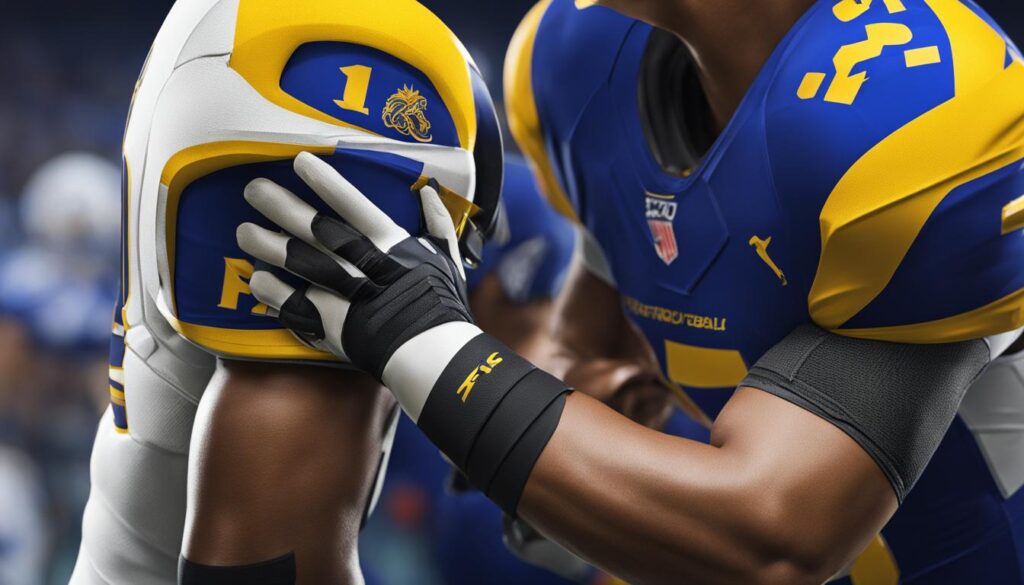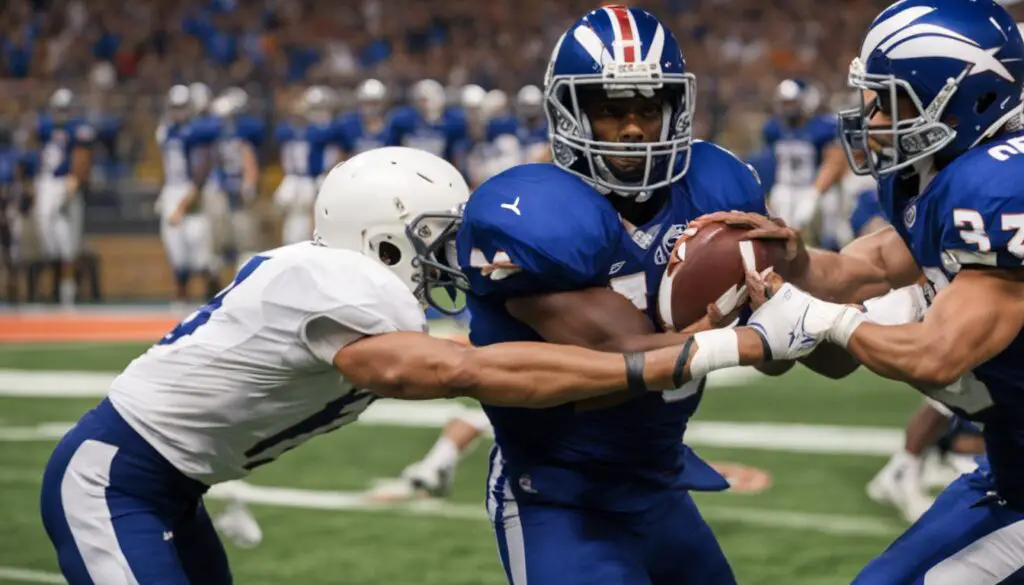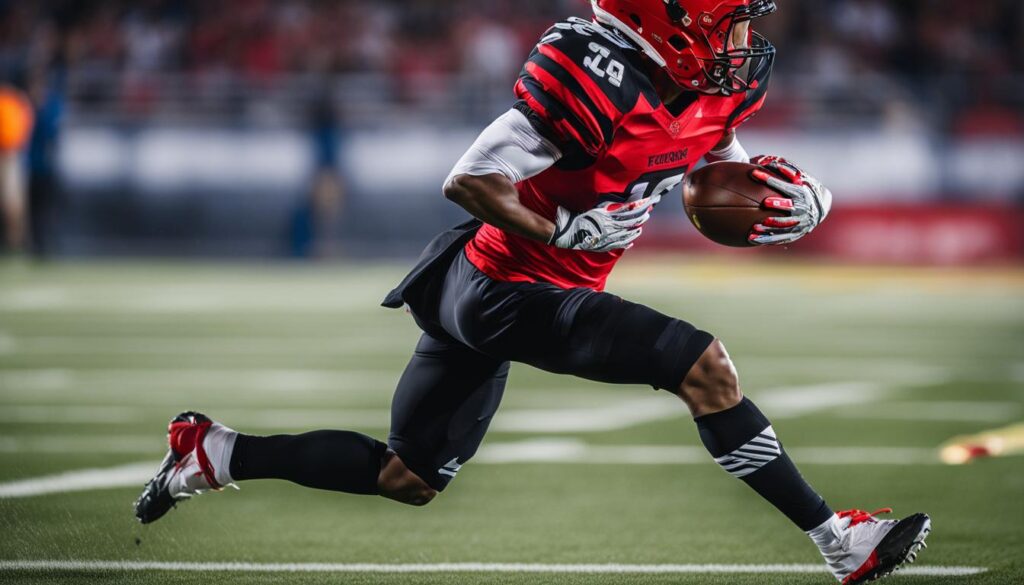Football players often tape the back of their arms for a variety of reasons. This practice involves using athletic tape to provide support, stability, and protection to their muscles and joints during games and training sessions.
So, why do football players tape the back of their arms? One of the main benefits is that taping helps reduce the risk of injuries, such as sprains and strains, by providing compression and support to the arm muscles. It also improves grip on the football and enhances performance on the field.
Another advantage of taping the arms is that it can help prevent sweating and chafing in the arm area during intense physical activity, ensuring player comfort and preventing distractions on the field.
Key Takeaways:
- Taping the back of their arms provides support and stability to football players’ muscles and joints.
- Athletic tape helps reduce the risk of injuries, such as sprains and strains.
- Taping enhances grip on the football and improves performance on the field.
- It also helps prevent sweating and chafing in the arm area during physical activity.
- Taping the arms is an essential practice for football players to optimize their performance and protect against injuries.
The Purpose of Taping Arms in Football
Football players often tape the back of their arms to provide support and protection to their muscles and joints during games and practices. The purpose of taping the arms in football is to enhance performance and reduce the risk of injuries. Taping techniques can vary, but they all aim to stabilize the muscles and joints in the arm area.
There are several common arm taping techniques used in football. One technique involves applying anchors on the shoulder and bicep to create a solid foundation for the tape. Another technique is the use of basket-weave strips that crisscross at the point of the shoulder, providing additional ligament support. Corkscrew strips, which wrap around the arm in a spiral motion, are also commonly used to offer compression and stability.
By taping their arms, football players ensure that their muscles and joints are supported and protected during the physical demands of the game. Taping can help reduce the risk of sprains, strains, and other arm-related injuries. It also provides a sense of stability, allowing players to have better control and grip on the football. Overall, the purpose of taping the arms in football is to optimize performance and safeguard against injuries.
Benefits of Taping Arms in Football
Taping the arms in football offers several benefits to players. One of the main advantages is that it provides compression and support to the muscles and joints, helping to reduce the risk of injuries such as sprains and strains. The tightness of the tape around the arm helps to stabilize the muscles and joints, preventing excessive movement that could lead to injury. Additionally, taping the arms can improve grip on the football, allowing players to have better control during catches and throws.
Another benefit of arm taping in football is that it helps to prevent sweating and chafing in the arm area. During intense physical activity, players can sweat, and the constant rubbing of the arm against the body or equipment can cause discomfort and irritation. By applying tape to the back of the arms, players can create a barrier that reduces friction and keeps the area dry, thus enhancing player comfort during games or practices.
“Taping the arms in football provides compression and support to the muscles and joints, reducing the risk of injuries and enhancing performance on the field.”
In summary, taping the arms in football has various benefits for players. It provides support and stability, reduces the risk of injuries, improves grip on the football, and prevents sweating and chafing in the arm area. By utilizing proper taping techniques and following best practices, football players can optimize their performance and minimize the likelihood of arm-related injuries.
Table: Comparing the Benefits of Arm Taping in Football
| Benefits | Description |
|---|---|
| Reduced risk of injuries | Taping provides compression and support to the muscles and joints, minimizing the chances of sprains and strains. |
| Improved grip | Taping enhances grip on the football, allowing players to have better control during catches and throws. |
| Prevention of chafing and sweating | Tape acts as a barrier, reducing friction and keeping the arm area dry and comfortable during physical activity. |
| Enhanced stability | Taping stabilizes the muscles and joints, preventing excessive movement that could lead to injury. |
Best Practices for Taping Arms in Football
Taping the arms in football requires careful technique and attention to detail to ensure maximum effectiveness. By following best practices, players can optimize the support and protection provided by arm taping. Here are some key tips and recommendations:
- Prepare the skin: Before applying tape, it is important to shave off any hair on the arm to ensure better adhesion. Additionally, using a pre-tape spray can improve the tape’s grip on the skin.
- Apply with correct tension: It is crucial to apply the tape with the right amount of tension. If it is too tight, it can restrict blood flow and cause discomfort. On the other hand, if it is too loose, it may not provide adequate support.
- Use quality supplies: Invest in high-quality athletic tape, rigid strapping tape, and elastic adhesive bandages. These supplies offer better durability and support, ensuring that the tape stays in place during intense physical activity.
- Avoid excessive tension: When laying the tape on the skin, make sure to avoid applying excessive tension. This can lead to discomfort and irritation. The tape should be snug but not overly tight.
By following these best practices, football players can enhance the effectiveness of arm taping and prevent injuries on the field. It is also recommended to consult with a trainer or medical professional for personalized guidance and advice.

Real-Life Example:
“I’ve been taping my arms in football for years, and following these best practices has made a noticeable difference in my performance. I always make sure to prepare my skin properly by shaving and using a pre-tape spray. Applying the tape with the right tension and using high-quality supplies ensures that I get the support I need without any discomfort. These simple tips have helped me stay injury-free and perform at my best.”
Remember, every player may have different preferences and needs when it comes to taping their arms. It is important to experiment with different techniques and adjust accordingly to find what works best for you. Regular practice and proper maintenance of the tape are also essential for maintaining its effectiveness throughout a game or practice session.
Importance of Arm Taping for Football Performance
Arm taping plays a crucial role in optimizing football performance by providing essential support, stability, and protection to the player’s muscles and joints. The practice of taping the back of the arms offers numerous benefits that contribute to better on-field performance and injury prevention.
Firstly, arm taping helps to stabilize the muscles and joints, reducing the risk of injuries during intense physical activities on the football field. By providing compression and support, taping minimizes the chances of sprains, strains, and other arm-related injuries. This is particularly important in football, where players constantly engage in aggressive movements and contact with opponents.
In addition to injury prevention, arm taping enhances the player’s grip on the football, allowing for better control during catches, throws, and ball handling. This improved grip can make a significant difference in crucial moments of the game, enabling players to maintain possession, execute accurate passes, and make impactful plays.
Furthermore, arm taping contributes to overall player comfort by preventing sweating and chafing in the arm area. This aspect is particularly relevant during physically demanding matches and training sessions when excessive sweating can compromise grip and performance. Taping helps to absorb moisture and reduce friction, ensuring that players can focus on their game without distractions or discomfort.
| Benefits of Arm Taping in Football |
|---|
| Reduces the risk of injuries such as sprains and strains |
| Improves grip on the football, enhancing control and performance |
| Prevents sweating and chafing, enhancing player comfort |
Overall, arm taping is an important practice for football players to optimize their performance and minimize the risk of injuries. By providing support, stability, and protection to the muscles and joints, taping allows players to perform at their best, giving them a competitive edge on the field.
Preventing Injuries with Arm Taping in Football
In football, where physicality and intense movements are integral to the game, preventing injuries is crucial for players. Arm taping is a technique widely used by football players to reduce the risk of arm-related injuries and improve overall performance on the field.
By providing support and stability to the muscles and joints, arm taping helps minimize the impact of blows or collisions during the game. The compression and protection offered by taping help to prevent sprains, strains, and other arm injuries that can hamper a player’s performance. Furthermore, taping supports the muscles and ligaments, reducing excessive movements that could lead to injury.
Regular use of arm taping as part of a player’s preparation can significantly contribute to maintaining their health and performance throughout the season. It is essential for players to follow best practices when taping their arms, such as using quality supplies and applying the tape with the correct tension. By prioritizing injury prevention with arm taping, football players can optimize their performance and stay competitive on the field.
| Benefits of Arm Taping in Football | Prevention of Arm Injuries | Enhanced Stability and Support |
|---|---|---|
| Reduced risk of sprains and strains | Minimized impact of blows and collisions | Support for muscles and ligaments |
| Improved grip on the football | Prevention of excessive movements | |
| Prevention of sweating and chafing |
Arm taping in football is not only a protective measure but also an essential component of a player’s performance. By providing stability, support, and protection to the arms, players can minimize their risk of injuries and maximize their potential on the field.

Football Arm Taping Techniques
There are various arm taping techniques used in football to provide support and stability. These techniques involve different taping methods and patterns to target specific areas of the arm, ensuring maximum effectiveness. Here are some commonly used football arm taping techniques:
1. Anchoring Technique
The anchoring technique involves applying the tape over the shoulder and bicep to provide support and stability to the arm muscles. This technique helps to protect the shoulder joint and reduce the risk of injuries during football activities. The anchor acts as a base for additional taping techniques and helps to secure the tape in place.
2. Basket-Weave Technique
The basket-weave technique is used to provide ligament support to the shoulder. It involves applying crisscrossing strips of tape over the shoulder joint, creating a basket-like pattern. This technique helps to stabilize the shoulder and reduce the risk of shoulder-related injuries.
3. Corkscrew Technique
The corkscrew technique is used to wrap the tape around the arm in a spiral pattern. This technique offers compression and support to the arm muscles, reducing the risk of strains and sprains. The corkscrew technique is commonly used to provide stability to the forearm and enhance grip on the football.
These are just a few examples of the arm taping techniques used in football. Players may use a combination of techniques or modify them based on their specific needs and preferences. It is important for players to consult with trainers or sports medicine professionals to learn the proper taping techniques and ensure correct application for optimal results.
| Technique | Purpose | Advantages |
|---|---|---|
| Anchoring Technique | Provide support and stability to the arm muscles |
|
| Basket-Weave Technique | Provide ligament support to the shoulder |
|
| Corkscrew Technique | Offer compression and support to the arm muscles |
|
How Arm Taping Enhances Football Performance
Arm taping is a crucial practice that enhances the performance of football players on the field. By providing support, stability, and protection to the muscles and joints, arm taping plays a vital role in reducing the risk of injuries and improving overall performance.
One of the benefits of arm taping is the compression and support it offers to the muscles and joints. This helps to reduce the risk of injuries, such as sprains and strains, by providing added stability. The tape acts as a barrier, limiting excessive movements and supporting the muscles and ligaments during intense physical activity.
Additionally, arm taping improves grip on the football, allowing players to have better control during catches and throws. The tape creates a secure surface, enhancing the player’s ability to handle the ball effectively. This improved grip can make a significant difference in crucial moments of the game.
Furthermore, arm taping helps to prevent sweating and chafing in the arm area, enhancing player comfort during intense physical activity. By keeping the arms dry and reducing friction, taping contributes to improved focus and concentration on the game, enabling players to perform at their best.

Table: Benefits of Arm Taping in Football
| Benefit | Description |
|---|---|
| Reduced risk of injuries | Taping provides support and stability to the muscles and joints, minimizing the risk of sprains, strains, and other arm-related injuries. |
| Improved grip on the football | Tape enhances grip, allowing players to have better control during catches and throws. |
| Prevention of sweating and chafing | Taping helps to keep the arms dry and reduces friction, enhancing player comfort and focus during the game. |
Overall, arm taping is a valuable practice in football that offers numerous benefits. It provides support, stability, and protection to the muscles and joints, reducing the risk of injuries and improving overall performance on the field. Whether it’s enhancing grip, preventing sweating, or offering added stability, arm taping plays a crucial role in optimizing a football player’s performance.
Conclusion
In conclusion, taping the back of their arms is a common practice among football players for good reason. The use of athletic tape provides crucial support, stability, and protection to their muscles and joints, reducing the risk of injuries and enhancing their on-field performance. By applying taping techniques such as anchoring, basket-weave strips, and corkscrew strips, players can target specific areas of their arms to provide the necessary support.
Following best practices, such as using high-quality supplies and applying the tape with the correct tension, is essential to ensure maximum effectiveness. By adhering to these guidelines, players can optimize the benefits of arm taping.
Arm taping plays a vital role in football preparation and performance, contributing to the overall success and well-being of the players. It allows them to perform at their best, maintain muscle and joint function, and minimize the risk of injuries. So, next time you see a football player with tape on the back of their arms, know that it’s not just a fashion statement but a strategic choice to enhance their game!
FAQ
Why do football players tape the back of their arms?
Football players tape the back of their arms to provide support and stability to their muscles and joints, reduce the risk of injuries, improve grip on the football, and enhance performance on the field.
What is the purpose of taping arms in football?
The main purpose of taping arms in football is to provide support and protection to the muscles and joints, reducing the risk of injuries and enhancing performance on the field.
How does arm taping help football players?
Arm taping helps football players by providing compression and support to the muscles and joints, reducing the risk of injuries such as sprains and strains, improving grip on the football, and preventing sweating and chafing in the arm area.
What are the best practices for taping arms in football?
Some best practices for taping arms in football include preparing the skin by shaving off any hair, applying a pre-tape spray to improve tape adhesion, applying the tape with the correct tension to ensure it is not too tight, and using quality supplies such as rigid strapping tape and elastic adhesive bandage.
Why is arm taping important for football performance?
Arm taping is important for football performance because it provides support, stability, and protection to the muscles and joints, allowing players to perform at their best on the field and reducing the risk of injuries.
How does arm taping help prevent injuries in football?
Arm taping helps prevent injuries in football by providing support and stability to the muscles and joints, reducing the risk of sprains, strains, and other arm-related injuries, and minimizing the impact of blows or collisions during the game.
What are some football arm taping techniques?
Some common football arm taping techniques include anchoring the tape over the shoulder and bicep, applying basket-weave strips that crisscross at the point of the shoulder, and using corkscrew strips to wrap around the arm.
How does arm taping enhance football performance?
Arm taping enhances football performance by providing support, stability, and protection to the muscles and joints, improving grip on the football, and preventing sweating and chafing in the arm area.
